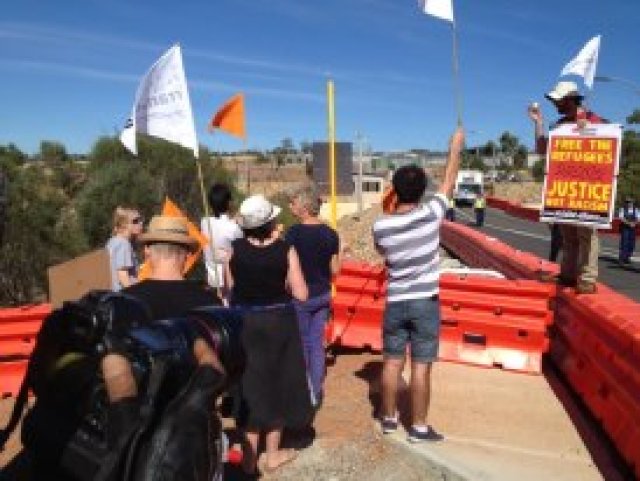
It’s a blight on the landscape. Participants of this year’s 11th annual refugee rights convergence gasped as the bus pulled off the Great Eastern Highway in Western Australia at the sight of the Yongah Hill detention centre.
The detention centre was built in June last year and was described by immigration media spokesperson Sandi Logan as “one of the most secure” centres in the entire refugee detention network.
“Secure” is an underrated description. Military compound is the first thing that comes to mind. A mess of fences, gates and floodlights rises up on a rocky hill dominating the beauty of the WA bush.
The formerly disused army barracks is surrounded by a double-perimeter fence, with a “sterile zone” lined with CCTV cameras, motion censors and an extra internal fence that can be electrified.
Inside this are multiple individual compounds — including housing, recreation, medical and reception — which refugees must walk between through caged walk ways.
During a candlelight vigil on the first night of the convergence, which took place on a hill opposite the detention centre, Perth refugee activists described the “minutia of control” under which refugees have to live in the centre.
Even during visits, visitors and refugees sit in rooms monitored by CCTV and a glass window for Serco guards to watch and listen in. When some regular visits grew popular, Serco guards cracked down on the visits, by refusing to allow anyone to move chairs around the room.
During their daily routine, several musters take place where refugees must report to a guard with their names, no matter what they are doing at the time.
It is this degree of control over their lives that grinds down the mental and physical health of the men inside, particularly when they are held for indeterminate months and even years.
The centre is built to hold up to 600 asylum seekers. At the moment it holds about 250 males.
All visits over the weekend were cancelled, even for family members unrelated to the convergence. The four to five layers of security, joined by a small army of police, prevented convergence-goers from getting anywhere near close to visual contact with the men inside.
But standing on the hill, holding lit-up balloons, candles and torches, refugee rights campaigners were assured that those inside could see them. One refugee joined the protest briefly by phone. He told the crowd, “Please free us,” to which the crowd responded with the chant “Free the refugees!”
The convergence is taking place over three days, April 26-28. Convergence attendees are camped nearby the detention centre, and will be rallying regularly outside the centre.
Even during visits, visitors and refugees sit in rooms monitored by CCTV and a glass window for Serco guards to watch and listen in. When some regular visits grew popular, Serco guards cracked down on the visits, by refusing to allow anyone to move chairs around the room.
During their daily routine, several musters take place where refugees must report to a guard with their names, no matter what they are doing at the time.
It is this degree of control over their lives that grinds down the mental and physical health of the men inside, particularly when they are held for indeterminate months and even years.
The centre is built to hold up to 600 asylum seekers. At the moment it holds about 250 males.
All visits over the weekend were cancelled, even for family members unrelated to the convergence. The four to five layers of security, joined by a small army of police, prevented convergence-goers from getting anywhere near close to visual contact with the men inside.
But standing on the hill, holding lit-up balloons, candles and torches, refugee rights campaigners were assured that those inside could see them. One refugee joined the protest briefly by phone. He told the crowd, “Please free us,” to which the crowd responded with the chant “Free the refugees!”
The convergence is taking place over three days, April 26-28. Convergence attendees are camped nearby the detention centre, and will be rallying regularly outside the centre.